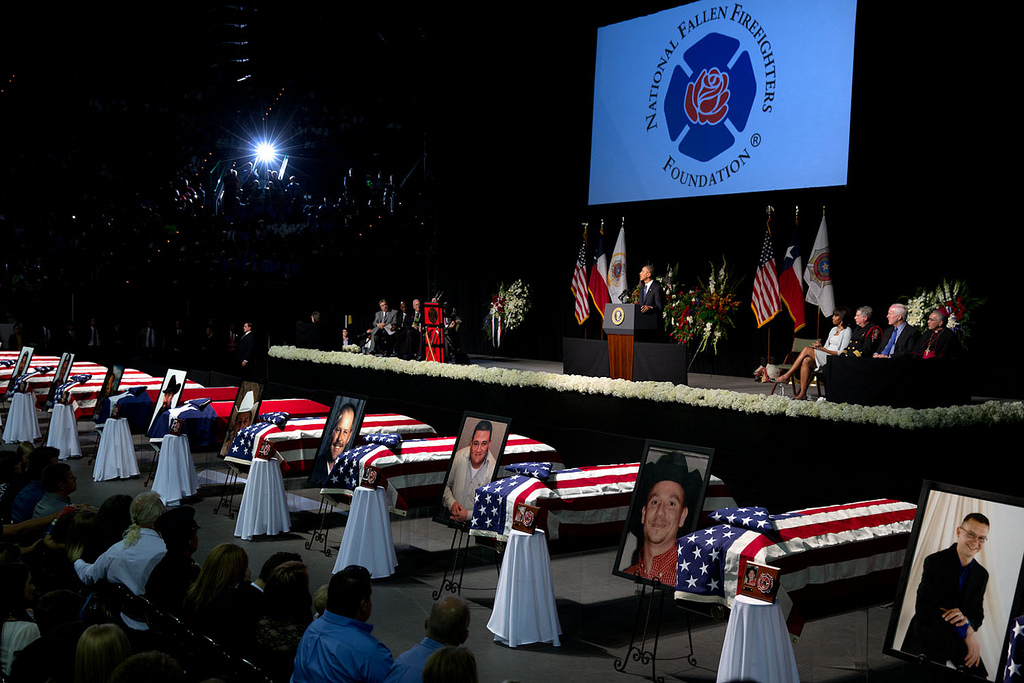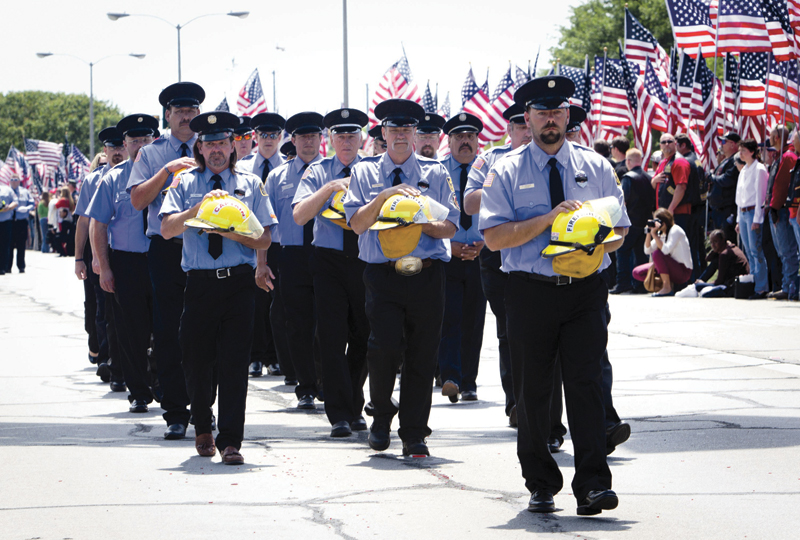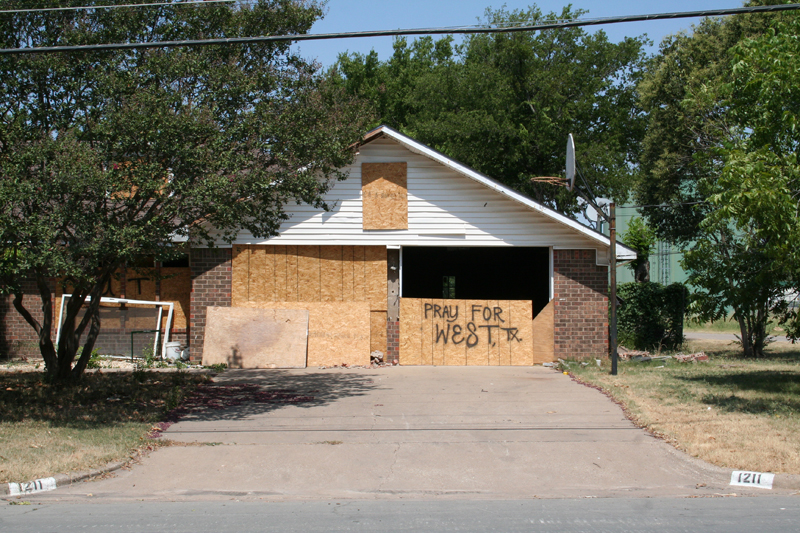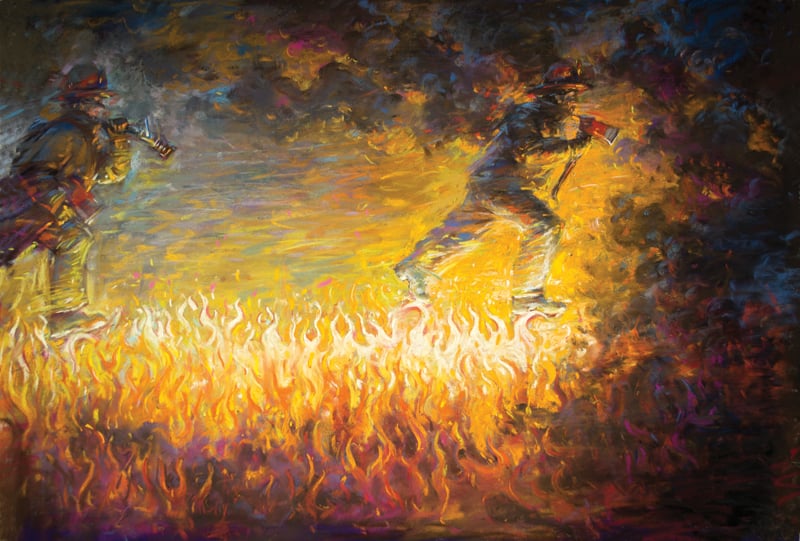
Hero Complex
Last year was the deadliest on record for Texas firefighters. Can dampening a culture of heroism keep them safer?

A version of this story ran in the April 2014 issue.
It was still dark when Grady Burke pulled up to the burning house in southeast Houston. Bright flames blazed against the black sky, and smoke tinted with an orange glow escaped through cracks in the roof. Burke, a 12-year veteran and captain in the Houston Fire Department, had been deployed to the fire as soon as he’d reported for his shift. Just after 6 a.m. on that chilly winter morning in 2005, he was the first officer on the scene.
Flames had eaten through most of the insulation and Sheetrock of the rear wall, leaving the house’s wooden skeleton exposed. Other firefighters began arriving on the scene. They knew the house was abandoned, but Burke decided on a “fast attack,” meaning he’d go inside, find the seat of the fire and extinguish it. Another firefighter kicked down the door, and Burke and firefighter David Pate carried a water hose inside.
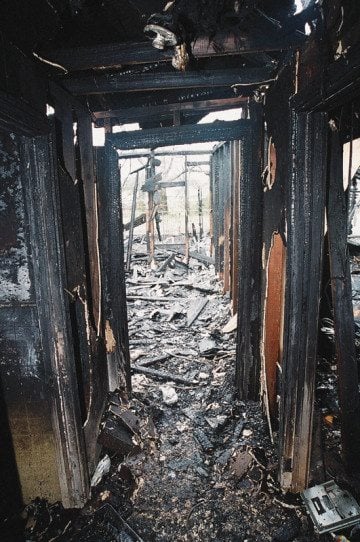
When they crossed the threshold, Burke and Pate stepped into a pool of trash and discarded clothes that came halfway up to their knees. The place had been a crack house, full of rubbish left by drug users and homeless people. The dense layer of junk slowed their progress, and thick smoke began to cloud their view as they ventured deeper inside.
They waded through the cluttered living room, crossed the dining room and were in the kitchen when they saw what looked like a river of flames coming down from the ceiling. Burke doused the ceiling with water and the flames disappeared. The two resumed their advance toward the den at the back of the house, still searching for the seat of the fire.
Seven other firefighters and a senior captain had followed them inside. The last three to go in, led by Stephen Jasinski, inched their way toward Burke and Pate. They could hear Burke’s hose and were an arm’s length from Pate, but the smoke was so thick they couldn’t see him or each other. Through the dense black curtain, Pate saw the river of flames on the ceiling return. There was a low rumble, then a crash. The house lit up, instantly turning each room into a furnace. Engine drivers standing outside watched their colleagues vanish in flames through the windows. Firefighters inside were knocked to the ground. The senior captain, Frank Currie, radioed for help. “We’re trapped!” he screamed. “Get out! Get out now!” Seconds later someone sounded the evacuation horn.
A disoriented Pate followed a wall until he saw the red lights of a fire engine through the window. He jumped through the glass to escape the inferno. Jasinski tried to fight the flames engulfing his team, but when he opened the nozzle on his line nothing came out. The fire had burned his hose in half.
Currie managed to crawl to the front of the house, where he trained a hose on two firefighters who had caught fire. Flames were covering the floor when he attempted to drag himself outside, and he had no choice but to spray water around him and await rescue. Some firefighters escaped on their own, but others had to be pulled from the house, now consumed in flames.
The scene was chaotic as firefighters emerged from the burning mass, a few of them still on fire. Currie hadn’t told anyone he was going inside, so when he was carried out everybody mistook him for Burke. When they realized Burke was still inside, firefighters tried to go back to save him, but it was too late. The roof in the den had collapsed over Burke, and the captain was pinned under 2 feet of debris when they found his body. The force of the crash had ignited the air—what’s known as flashover—and the abundant furniture and flammable junk in the house provided the perfect fuel to maintain the fire. During flashovers, buildings can reach temperatures of 1,100 to 2,000 degrees Fahrenheit. The firefighters got out before their protective equipment and gear had time to char—most gear can withstand temperatures upwards of 550 degrees—but five suffered thermal burns, even through their intact gear, that required medical attention. Extreme heat crystallized some men’s masks.
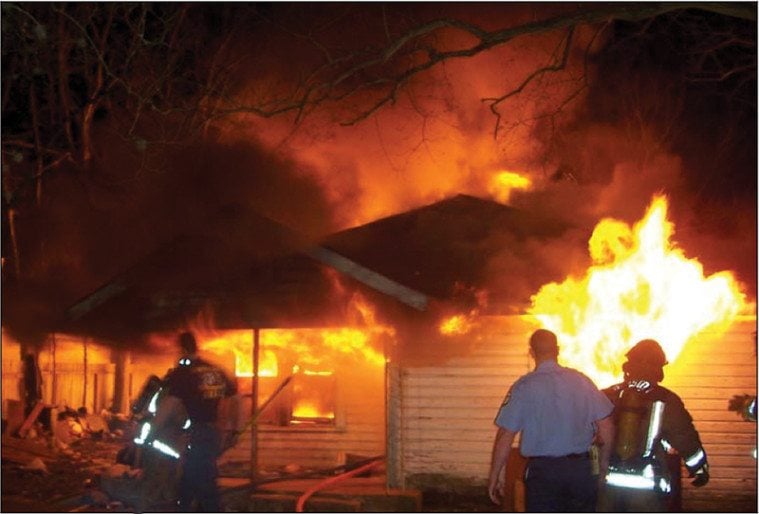
The tragedy unfolded in minutes. From the time Burke decided to enter the house to the time the roof caved and fire incinerated the structure, only six minutes and 48 seconds had elapsed. In those moments, the Houston Fire Department lost a career firefighter and came dangerously close to losing several others. As firefighters retraced the event in their statements, and the State Fire Marshal’s Office began its investigation, one question emerged: Could Burke’s death have been prevented? The State Fire Marshal’s report released 16 months later suggests the answer is yes.
There’s a saying in the fire service: risk a lot to save a lot, risk a little to save a little, and risk nothing to save nothing. When Houston firefighters entered the abandoned crack house that February morning in 2005, they didn’t do so with the intention of saving lives; they knew the house was empty, so the objective was solely to extinguish the fire. Abandoned houses are particularly precarious, and firefighters described the building as “heavily involved” in flames. Therefore, the report concludes, fighting the fire from the outside—what the fire service calls a “defensive attack”—would have been more effective and could have spared Burke’s life.
The report highlights a little-known problem: In their desire to save lives and property, to be a hero, firefighters sometimes rush into buildings when restraint is called for. It’s a problem that some fire chiefs and the state fire marshal are trying to address following one of the deadliest years for firefighters in Texas history.
There’s an idea of heroism that often colors firefighters’ perceptions of the job. It’s the Hollywood image: the fearless firefighter diving into a burning building and emerging with a child slung over a shoulder. Soon after graduating from the academy, firefighters realize those incidents are actually unusual and that the job more often involves handling mundane assignments and smaller fires. The rare large blazes become their chance to be the heroes they believe they’re expected to be—and some take disproportionate risks to earn the reputation.
Fire departments favor aggressive candidates who aren’t afraid of the myriad hazards the job poses. The tendency to hire strong-willed alpha males—as most firefighters describe themselves and each other—into an aggressive and stubborn culture can be a deadly combination.
These factors can coalesce into what Plano Fire Chief Brian Crawford calls the “firefighter duty-to-die syndrome.” Crawford holds a master’s degree in industrial psychology and has written and lectured about the topic nationally. Before coming to Texas, he served as fire chief in the Shreveport, Louisiana, fire department where he began his career 30 years ago. The city of Charleston, South Carolina, commissioned Crawford and other experts to investigate a structural fire that killed nine firefighters in 2007, and he’s part of the task force that is investigating the line-of-duty deaths at the fertilizer plant explosion in West, Texas.
According to Crawford’s theory, firefighters feel it’s their duty to take unnecessary risks—even if that means dying or risking others’ lives—because they are trying to fulfill a notion they have about what a firefighter should be: a bold and selfless hero. Typically that attitude is institutionalized within fire departments, so that veterans praise and respect rookies who act brashly. “Some cultures of some organizations [have] the mentality that, ‘We’ve got to live up to this image of this macho firefighter, and we’ve got to go in every fire; we can’t fight it from the outside or it’s going to make us look weak,’” Crawford says. That culture encourages jumping in immediately and pushing to the physical limit.
“Are you going to be called chicken? Are you going to take a ribbing from your buddies, because you didn’t go into that property?” Crawford says, adding that some firefighters wear the nicknames “fire dog” and “smoke eater” as badges of honor. Back when firefighters didn’t have the Self-Contained Breathing Apparatus that protects them from inhaling smoke, they went inside fires and “ate” smoke and soot. “If you weren’t a smoke eater, then you weren’t a real firefighter. If you didn’t cough up and blow black snot and black secretions out of your mouth for a week after a fire, then you weren’t a real firefighter. Some of that mentality still exists today. … There are some fire departments in this country that believe that that is their measure of a firefighter. And that has nothing to do with firefighting [today], because firefighting [today] is educated, aggressive and a very risk-versus-gain scenario.”
That mentality reflects a larger professional dichotomy that preaches safety at every turn but disregards it in practice. Too often firefighters die because they ignore safety standards and take unnecessary risks. Last year, the Texas fire service was forced to confront this reality after 17 firefighters died combating blazes—one of the deadliest years the state has ever seen. The fertilizer plant explosion that decimated West in April claimed 10 of those lives and seven more died in three other fires before the year was half over. The details of those fires remain a mystery—the State Fire Marshal’s Office has yet to complete its reports and is working through a record number of investigations—but preliminary information suggests that an adherence to basic firefighting safety practices could have prevented at least some of those deaths.
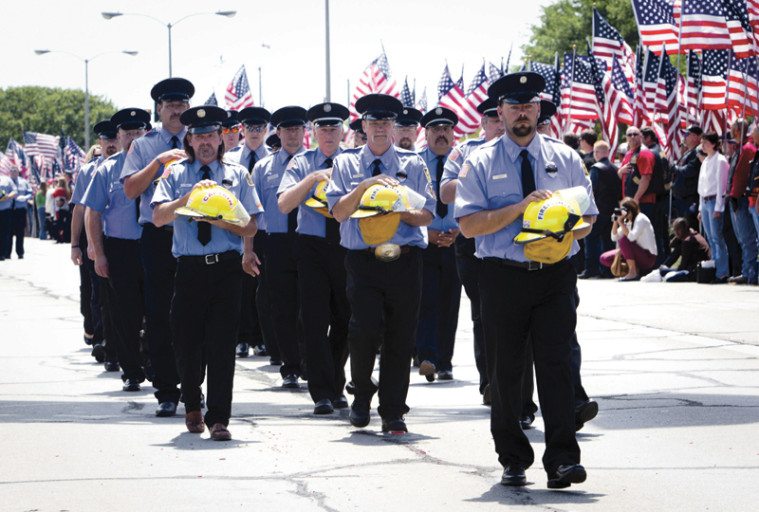
What we do know is that many firefighter deaths in recent years could have been prevented. Since 2001, the State Fire Marshal’s Office has produced a report each time a firefighter died in the line of duty. In each report, investigators outline the “best practices” firefighters should have followed and whether ignoring those best practices contributed to the death. The answer is often yes. The Observer examined every firefighter death report since 2001. In 80 percent of the cases in which firefighters died engaging blazes, investigators concluded there hadn’t been enough—or any—risk-versus-gain assessment before attacking the fire.
That echoes the findings of national reports. Since 1998, the National Institute for Occupational Health and Safety has been investigating why an average of 100 firefighters die every year in the line of duty. The institute found that firefighters consistently ignore best practices, such as failing to put an officer in charge of an emergency scene (called “incident command”), to communicate during fires, and to assess risk versus gain at every fire.
Evaluating risk versus gain requires firefighters to refer back to the old mantra of trade-offs. If there’s no possibility of saving a life, a firefighter isn’t supposed to risk losing his or her own. If conditions are such that a person inside likely couldn’t survive, a firefighter shouldn’t risk death to recover bodies. Where only property can be saved, a firefighter should risk little to nothing.
But in practice, that often doesn’t happen. An Observer analysis found that two-thirds of all Texas firefighters who died combating blazes between 2001 and 2012 perished in fires where saving a life was not the objective. That means 11 firefighters died in 10 fires where there weren’t any victims to rescue, and the main goal was to put out the fire. In some cases, there wasn’t much salvageable property, either.
But that mindset may be starting to change after tragedies in two small towns rattled the firefighter community and made the need for change a pressing issue. The two fires, one in West, and the other in Yarnell, Arizona, together claimed the lives of 29 firefighters. In West, the blaze precipitated an explosion that killed 15, injured 200 and destroyed much of the small town.
Kevin Maler and his brother David were working in Kevin’s shop outside his house the evening of April 17, 2013, when a neighbor started yelling and gesturing toward the sky while running toward his truck. The brothers couldn’t hear the neighbor, Kirk Wines, over their power tools, but stopped to see what he was frantically pointing at. David went around the house and saw smoke coming from the West fertilizer plant across the field, less than a mile away. The brothers, who, like Wines, were volunteer firefighters, jumped in Kevin’s truck and headed toward the plant.
Just before the Malers arrived, a former plant employee called Kevin and asked what was on fire. As they pulled up to the scene, Kevin told him it was the fertilizer mixing building. The man told him the firefighters needed to be at least a quarter-mile away from the plant in case it blew.
Kevin parked his white truck on the road outside the plant. David ran to join the firefighters already attacking the blaze. Most of the firefighters knew the building stored ammonium nitrate, and at least some of them knew the fertilizer was an explosive. But most of them had grown up in West and had played in fields around the plant as children without so much as a whisper about the dangers inside. They’d watched their small town expand toward the plant, with houses, schools, and a nursing home rising around it. The possibility of an explosion seemed a distant one, and on that night, it was obscured by a larger fear: that the plant’s tanks of anhydrous ammonia—a potentially lethal colorless gas—would leak.
West firefighters had been called to the plant before to secure the tanks after thieves had tried to steal the chemical (anhydrous ammonia is used in illicit production of methamphetamine). Many of the firefighters thought ammonium nitrate, on the other hand, was a stable chemical that didn’t pose a hazard to the community.
According to an EPA advisory released in the wake of the explosion, pure ammonium nitrate is a stable chemical that “will explode only under extraordinary circumstances”—for example, the combination of confinement, added pressure and heat seen in West. It’s unclear exactly how much of this information first responders knew, but whatever information they had, they had rushed to the fertilizer plant for a simple reason: They wanted to protect their families, their neighbors and their town.
The first firefighters to arrive sprayed water from their fire engines on the south side of the plant, unaware of their proximity to the approximately 50 tons, or 100,000 pounds, of ammonium nitrate. One firefighter went to the nearest water hydrant but found the hose was too short to reach the blaze.
While David rushed to join the others, Kevin stayed on the road to talk to West Fire Chief George Nors. Kevin relayed what the former plant employee had told him, then headed to the fire station to pick up protective gear for himself and his brother.
Nors found Cody Dragoo, the plant foreman who was also a West volunteer firefighter. He asked Dragoo if the plant was likely to explode, and if they should pull out and focus on evacuation. According to Nors, Dragoo told him it wouldn’t blow.
The firefighters soon realized the fire was getting too big, too hot, and that they didn’t have enough water to control it. They talked about backing off and returning with reinforcements. After talking to Dragoo, Nors headed back toward the road where he’d parked a water tanker. He had walked for about 30 seconds when the plant blew.
The fire had found the ammonium nitrate. It encircled the chemical, which was already becoming unstable under containment and heat in the fertilizer mixing room. The ceiling collapsed onto the ammonium nitrate, adding pressure, the final ingredient needed for detonation. About 28 to 34 tons of fertilizer detonated—the equivalent of 15,000 to 20,000 pounds of TNT—resulting in an explosion three to four times more powerful than the 1995 Oklahoma City bombing that made ammonium nitrate infamous. And that was only one of two piles of fertilizer inside the plant—another 20 tons or so remained intact. A nearby railcar, knocked over by the blast, held another 100 tons of fertilizer, and those pellets also remained intact.
Nors woke up later, his face pockmarked by gravel and his clothes covered in dirt from being knocked to the ground. The explosion blew out his hearing aids, ruptured his eardrums and gave him a concussion, causing bleeding in his brain.
More than a mile away, Kevin Maler felt the fire station shake. Ceiling tiles and everything hanging on the walls came crashing down. He immediately knew what had happened. He raced back to his truck. He sped to the plant, running over the debris that blocked the road.
The explosion had turned the area into a disaster zone. The plant was gone, in its place a crater 93 feet across and 10 feet deep. Chunks of concrete, ripped metal and earth had gone flying thousands of feet, crushing cars, obliterating buildings and setting three houses and a school on fire. Smoldering piles of debris littered the ground. Bodies and limbs lay scattered among the rubble.
The first person Kevin saw was Emmanuel Mitchell, the assistant fire chief, who was covered in white dust and had shrapnel in his back. Kevin asked where his brother was, and Mitchell pointed to David’s mangled fire truck.
As he neared the remains of the red fire engine, Kevin saw the body of one of his friends. He spotted another body nearby and suddenly that body was moving. His brother got up and walked toward him. The shockwaves of the blast, which had crumpled cars like pieces of paper and taken out entire walls, had stripped David’s clothes clean off; only his belt and the pockets of his pants, his underwear and the collar of his white t-shirt clung to his broad frame. His black Under Armour tennis shoes remained tied on his feet.
David Maler was one of five West firefighters injured that night. Five others died in the explosion. A Dallas Fire Department captain and four volunteer firefighters from nearby towns also lost their lives, as did two West residents who had come to help first responders and who were later named honorary firefighters. Three civilians died during or immediately following the explosion, and hundreds were injured.
The tragedy highlighted abundant holes in ammonium nitrate regulation at both state and federal levels, sparking rounds of hearings in the U.S. Senate and Texas House that have yet to result in conclusive action. The presence of two different kinds of hazardous materials at the plant and the danger they posed to an entire community make this case significantly more complex than others in which firefighters have died. But like other tragedies, pre-existing best practices suggest firefighters could have done things differently.
Texas Fire Marshal Chris Connealy can’t address West because of his office’s ongoing investigation, so he speaks in general terms. National best practices dictate that first responders develop plans for managing emergencies at structures containing hazardous materials. Had the West Volunteer Fire Department had a plan for the fertilizer plant, firefighters might have known what conditions could make ammonium nitrate detonate and would have likely focused on evacuation.
“You have to be cognizant of what’s there, have an understanding of those products, and in many cases the right answer is not engaging the fire,” Connealy says.
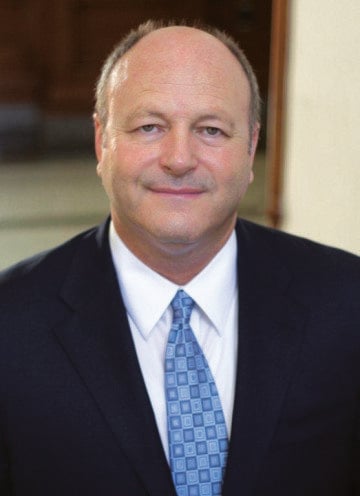
Connealy has spent much of his career trying to make firefighters understand that they’re often better off taking a less aggressive approach. In February of 2000, two Houston firefighters died when the roof of a McDonald’s collapsed. Firefighters had decided to make a “fast attack” and venture inside the building, which had flames through the roof when they arrived. As in Burke’s case, it was only after the collapse that the incident commander on the scene switched to a defensive attack.
At the time, Connealy was an officer in the Houston Fire Department. The following year, he was promoted to fire chief. That same year, 2001, a 20-year veteran and captain died from asphyxiation after becoming disoriented while trying to find a man in a burning 41-story apartment tower.
Before the McDonald’s fire, Connealy says, most of the department couldn’t remember losing a colleague solely to a blaze. Three deaths in two years was unprecedented. As chief, he created a safety plan based on the lessons learned from the two incidents. He made it mandatory for all 3,400 Houston firefighters to sit through a training session to review the fires and the new safety plan, but only half the department got through the sessions before he retired. Some firefighters readily accepted the changes, he says. Others resisted.
Tradition is highly valued in the fire service, making any significant reform move at a glacial pace, even with the most dedicated and concerted effort by department leaders. In Houston, each mayor appoints a new fire chief—that’s why Connealy retired from the Houston department and became chief in Cedar Park. That leaves chiefs with a maximum of six years to institute cultural change in a vast department where aggression is valued.
Three months after leaving Houston, Connealy found out another firefighter had died and two had been seriously injured in a nightclub fire. The case bore a strong similarity to the previous ones, with the same breakdowns in communication, lack of incident command and poor risk assessment. The recommendations in the resulting report echoed the best practices that Connealy had tried to instill during his short time as chief.
Less than a year later, Burke died in the crack house fire. Three separate reports pointed to the lack of “risk-versus-gain” assessment at the fire that took his life. The department’s internal report and the state and national reports all said the same thing: If anyone had stopped to weigh the possibility of firefighter death and injury against saving part of an abandoned building, that person would have determined that firefighters never should have set foot inside.
But on that day in February 2005, no one seems to have paused to make a risk assessment. Only three minutes passed between the units leaving the fire station and Burke announcing he would go inside to put out the fire. The time-stamped report, which logs each firefighter action and radio communication to the second, makes no distinction between Burke’s arrival and his announcement of the “fast attack.” That means he made the decision to enter the house in the mere seconds it took for the engine to pull up to the scene. Firefighters who arrived with Burke knew the back wall was consumed in flames, meaning Burke likely also had that information.
Four years later, in 2009, two firefighters died in another house fire in Houston. Again, the recommendations sounded painfully familiar and mentioned risk management.
“In this risk versus gain, the risk is the firefighters’ lives,” Connealy says. “The gain is that we’re going to save us a civilian that’s trapped, which is what we’re sworn to do and want to do.”
Last May, four Houston firefighters died while responding to a hotel fire, the most the department has ever lost in one year. The Houston Fire Department is twice the size of the next-biggest department in the state, Dallas, but other metropolitan departments don’t come anywhere close to Houston in terms of losing members to fires. Since 2000, Houston has lost 11 firefighters to blazes; Dallas has lost two. San Antonio hasn’t seen a fire-operations death since 1997 and Austin hasn’t had one since the 1970s.
It’s enough to make one wonder whether the culture of the Houston Fire Department is particularly aggressive, or at least has been in the past. Change is especially hard to enforce in a large department, and Houston is among the five biggest in the nation. Outdated ideas and practices remain more entrenched there than in some of the smaller departments that are easier to turn around.
Since Connealy took the reins of the State Fire Marshal’s Office almost two years ago, he’s been trying to encourage cultural change that emphasizes safety at the state level. After a volunteer fire captain died following a training exercise in 2012, the Fire Marshal’s Office for the first time produced a report that calls out firefighters for disregarding best practices. State line-of-duty death reports have historically been a gentle nudge on the shoulder, sensitive to the heroic sacrifice and the tragedy of firefighter deaths. But this 2012 report outlines all the actions the course instructors failed to take to ensure students’ safety—and all the things they did to endanger it—in stern and transparent language. Connealy says upcoming reports for 2013 deaths in Bryan, West, Dallas and Houston will take a similar approach.
“I’ve gotten quite a bit of road rash, but it’s the right thing to do,” Connealy says. “I hate to see firefighters die in the line of duty, especially when it could have been prevented.”
Many progressive fire chiefs across the state are already emphasizing safe firefighting within their departments and enforcing national best practices, Connealy says, but others still refuse to embrace safety. “We’re going to put pressure on them to change their tune or they shouldn’t be fire chief,” he says.
Throughout the nation, fire service leaders and groups are studying firefighter fatalities and urging cultural change. An oft-cited 2010 study found that the number of structural fires in the U.S. has gone down, but firefighters are dying in structural fires at a higher rate than ever before.
“We’re not finding new ways for firefighters to die in a fire; it’s the same things time and time again,” Connealy says. “The definition of crazy is doing the same thing and expecting to get different results. You’re not going to get different results.”
Changing the culture is key to preventing deaths, and is the biggest challenge facing the fire service today. Alan Brunacini, one of the most respected fire chiefs in the nation, who has written several books used in most fire academies and who invented the incident command system, says the antidote to unnecessary deaths lies in training and leadership.
Young firefighters in academies are being taught to be much safer now than Brunacini and his peers were decades ago, but they still possess the eagerness, energy and lack of experience that come with being a rookie. Brunacini says it’s essential for seasoned firefighters in leadership to rein in rookies’ exuberance. Unfortunately, those older officers are typically the same firefighters who came up in a culture that celebrated fearlessness, and who still swear by the old values of proving toughness and risking everything. Anyone who is put in charge of others’ lives, Brunacini says, should be trained and retrained on safety and the latest best practices. Connealy makes the same point.
“If you’re not going to be the leader and take responsibility for that fire department and do what it needs to do, then you shouldn’t be fire chief,” Connealy says. “But that goes all the way down; from the rookie firefighter to the fire chief, everyone has responsibilities. No one’s off the hook.”
The Texas Fire Chiefs Association conference, which was held in February this year in San Marcos, aims to bring the latest information to department leaders and encourage them to learn from each other. Safety was the main focus of the four-day event in which fire leaders from all over the state attended sessions and mingled. Before the conference, the association offered two days of workshops that included a training program called “Everybody Goes Home,” the sole purpose of which was to reduce firefighter deaths. The program is based on 16 “life safety initiatives.” No. 1 on the list is cultural change; no. 3 is risk management (risk versus gain).
During the conference, the Bryan chief gave a presentation on a fire that killed two firefighters and critically injured two more in his department last year. Another presentation stressed leadership, and another, about protective gear, tried to debunk the apparently widely held notion that old, worn firefighting helmets are “gauges of bravery” and “billboards of experience.”
The split in the fire service—between leaders who embrace updated practices and those who reject change—was evident in the hotel ballroom. Some fire chiefs sat back with arms crossed and scoffing smirks on their faces during the presentations.
But others were attentive and involved in the conversation, and the presenters were impassioned. It’s those leaders who are giving Texas a reputation for protecting firefighters. For instance, Texas recently became the first state in the union to create its own accreditation program for firefighting best practices, largely modeled after a similar program for law enforcement. So far only the Irving department has completed the program, but other departments are pursuing certification.
In February, the National Fallen Firefighters Foundation recognized Texas for requiring all paid firefighters and officers, fire inspectors, investigators and instructors to complete the Everybody Goes Home program. On his ammonium nitrate education tour across the state—where he is speaking mostly to rural residents and volunteer fire departments—Connealy is pushing the program’s 16 safety initiatives. “We’re going to keep on pounding it,” Connealy says. “The sole mission is to keep firefighters alive.”
He says he will continue to work with the state’s chiefs on changing the firefighting culture in Texas and preventing another year like 2013 from happening. “We are all on the same sheet of music and we are sick and tired of what’s going on,” he says. “The cost is way too high.”
